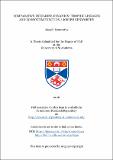Files in this item
Comparative estuarine dynamics : trophic linkages and ecosystem function
Item metadata
| dc.contributor.advisor | Paterson, D. M. (David M.) | |
| dc.contributor.advisor | Bishop, Melanie J. | |
| dc.contributor.author | Kenworthy, Joseph | |
| dc.coverage.spatial | 254 | en_US |
| dc.date.accessioned | 2016-02-16T11:13:31Z | |
| dc.date.available | 2016-02-16T11:13:31Z | |
| dc.date.issued | 2016-02-01 | |
| dc.identifier.uri | https://hdl.handle.net/10023/8240 | |
| dc.description.abstract | Estuarine systems are of crucial importance to the provision of goods and services on a global scale. High human population densities in coastal systems have caused an increasing input of pollutants, of which nutrient pollution is of major concern. Increasingly, these areas are also impacted by physical disturbance, which can originate from anthropogenic sources (e.g. bait digging, shipping) or climate change causing increasingly frequent and intense storms. The individual impacts of such stressors on ecosystems have been investigated however their combined impacts have received less attention. Cumulative impacts of multiple stressors are unpredictable and will likely result in non-additive effects. Further, the effect of local environmental context on multiple stressors is a relatively understudied topic. Work in this thesis compared the combined impact of nutrient enrichment and physical disturbance in Scotland and Australia, using a series of manipulative field experiments. Results demonstrate that response to stressors is highly context dependent, varying between and within geographic locations. While the background levels of stress may vary, by comparing these two locations it is possible to comment on the adaptations and response that communities within different parts of the world display when subjected to additional stress. This study demonstrates that environmental context must be considered when implementing future management practices. Further work demonstrated that the impact of multiple stressors varies depending on how the stress is applied –whether stressors are applied simultaneously or whether there is a delay between two stressors. This study was among the first of its kind, assessing the implications of how multiple stressors react with each other given the order and intensity in which stressors were applied. Results demonstrated that systems can become sensitised to stress making them increasingly vulnerable to additional stress. Future research should be focussed on incorporating ecologically relevant scenarios of how stressors will impact estuaries while considering how environmental context will mediate impacts. | en_US |
| dc.language.iso | en | en_US |
| dc.publisher | University of St Andrews | en |
| dc.subject | Intertidal | en_US |
| dc.subject | Estuarine | en_US |
| dc.subject | Ecology | en_US |
| dc.subject | Multiple stressors | en_US |
| dc.subject | Sediment | en_US |
| dc.subject | Macrofauna | en_US |
| dc.subject | Environmental context | en_US |
| dc.subject | Nutrient enrichment | en_US |
| dc.subject | Disturbance | en_US |
| dc.subject.lcc | QH541.5E8K4 | |
| dc.title | Comparative estuarine dynamics : trophic linkages and ecosystem function | en_US |
| dc.type | Thesis | en_US |
| dc.type.qualificationlevel | Doctoral | en_US |
| dc.type.qualificationname | PhD Doctor of Philosophy | en_US |
| dc.publisher.institution | The University of St Andrews | en_US |
| dc.publisher.department | Macquarie University | en_US |
| dc.identifier.doi | https://doi.org/10.17630/10023-8240 |
This item appears in the following Collection(s)
Items in the St Andrews Research Repository are protected by copyright, with all rights reserved, unless otherwise indicated.

